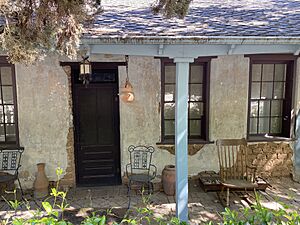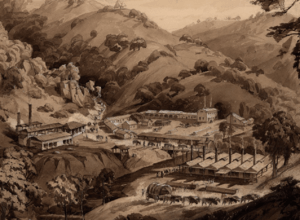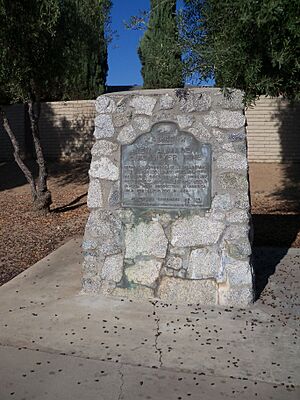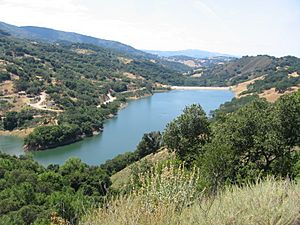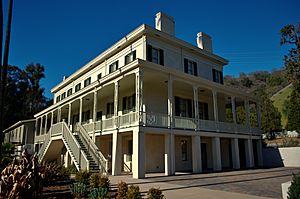New Almaden facts for kids
Quick facts for kids
New Almaden
Spanish: Nueva Almadén
|
|
|---|---|
|
Neighborhood of San Jose
|
|
| Country | United States |
| State | California |
| County | Santa Clara |
| Elevation | 492 ft (150 m) |
| Time zone | UTC-8 (Pacific (PST)) |
| • Summer (DST) | UTC-7 (PDT) |
| ZIP code |
95042
|
| Area code(s) | 408 |
| GNIS feature ID | 1659212 |
New Almaden, also known by its Spanish name Nueva Almadén, is a special historic place in San Jose, California. It's famous for being home to the oldest mercury mines in California. These mines are located in the Capitancillos Hills, at the southwestern edge of Almaden Valley.
New Almaden is split into two main areas. One part includes the old mines and the historic settlements around them, which are now part of the Almaden Quicksilver County Park. The other part is a residential area with historic buildings, like the famous Casa Grande.
Mexican settlers first found the mercury here in the 1820s. For a long time, these mines were among the most productive mercury mines in the United States. Even before the Spanish, Mexicans, and Americans arrived, the native Ohlone people used the area. They collected a bright red mineral called cinnabar to make paint.
Contents
Exploring New Almaden's Past
The Ohlone people used cinnabar, a red mercury ore, for paint. But later settlers realized it could be used to produce quicksilver. Secundino Robles was the first settler to discover the mine in 1824. He later owned parts of the mine with his brother.
In 1846, Andres Castillero, a captain in the Mexican Army, received a grant for the mine. However, he was busy with military duties during the Mexican War. So, he sold his claim to Barron, Forbes Company, an English company. Alexander Forbes gave the mine its name, "Nueva Almaden."
The mine was named after a very old mercury mine in Almadén, Spain. That Spanish mine had been running since Roman times! The word "Almadén" comes from the Arabic language and simply means "the mine."
There were some legal disagreements about who truly owned the mine. In 1863, during the American Civil War, President Abraham Lincoln tried to take control of the mine. However, armed miners stopped the federal agents at the mine gates. The government decided not to push the issue, as they didn't want to lose California's support during the war.
Because of this, Barron, Forbes Company was allowed to sell the mine. American investors bought it for $1.75 million.
Arthur De Wint Foote worked at New Almaden in the late 1870s. His wife, Mary Hallock Foote, was an artist and writer. She drew detailed pictures and wrote about life at the New Almaden Mine. Her stories, called "A California Mining Camp," were published in Scribner's Monthly in 1878. She also wrote a memoir, A Victorian Gentlewoman in the Far West, which inspired the novel Angle of Repose.
Understanding the Environment
Mining operations at New Almaden caused some water pollution in the Guadalupe River and parts of the South San Francisco Bay. This pollution affected birds and other animals living in the water.
In 2005, several companies and local government groups agreed to pay about $6.75 million. This money was used for projects to clean up the environment. The California Department of Fish and Wildlife and the US Fish and Wildlife Service created a plan in 2008 to restore the area.
Geology of the Mines
The New Almaden mining area is part of a larger geological region called the Franciscan Assemblage. This area is known for its quicksilver ore, which is cinnabar. Cinnabar was formed deep underground by hot water moving through rocks. It's found in a type of rock called silica-carbonate.
While there were other smaller mines nearby, New Almaden was by far the most important. Most of the mining was done underground.
New Almaden Mines: A National Landmark
|
New Almaden
|
|
| Area | 3,200 acres (1,300 ha) |
|---|---|
| Built | 1854 |
| NRHP reference No. | 66000236 |
| Significant dates | |
| Added to NRHP | October 15, 1966 |
| Designated NHL | July 4, 1961 |
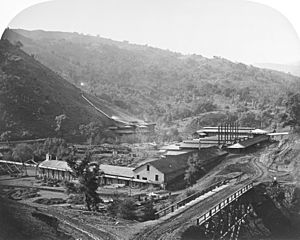
Today, the entrances to the old mines are closed for safety. After being identified as a "Superfund" site (a place needing environmental cleanup), the mining area was cleaned up. Now, you can visit it as part of the Santa Clara County Almaden Quicksilver County Park.
In 1961, New Almaden was recognized as a National Historic Landmark. This means it's a very important historical site in the United States. By the time Santa Clara County bought the mines in 1976 and stopped operations, over 83 million pounds of mercury had been taken out! That was worth more than $70 million.
You can still see the remains of many buildings from the 135 years of mining. These include homes for the up to 1,800 miners. The biggest collection of these structures is at English Camp, which was built by miners from Cornwall in the 1860s.
Two California Historical Landmark markers celebrate the New Almaden Mine. Marker #339 points to a cinnabar hill where Native Americans collected pigment. Marker #339-1 is near Arroyo de los Alamitos Creek, where the actual mining first began. There is also a museum nearby.
Almaden Quicksilver County Park
Almaden Quicksilver County Park is a huge park, covering about 4,147 acres (17 square kilometers). It includes the land where the old mercury ("quicksilver") mines used to be. The park's height changes a lot, from less than 600 feet (183 meters) at the entrances to over 1,700 feet (518 meters) at its highest point. Sometimes, during cold winter storms, the highest parts of the park get a light dusting of snow.
The County of Santa Clara owns and manages this park. The Guadalupe Reservoir is also within the park's grounds, and the Almaden Reservoir is right next to it. You can learn more about the area at the Casa Grande Almaden Quicksilver Mining Museum.
From Mines to Park
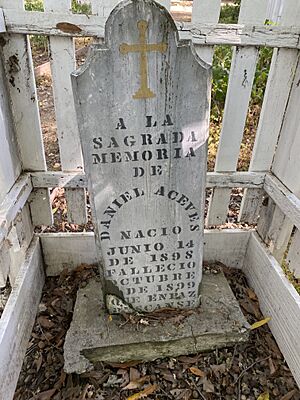
Santa Clara County bought the mining property in 1976. Soon after, they started planning to turn it into a park. This was a time when the county was creating many new parks quickly.
The county parks director wanted to create a historic park. Visitors could learn about the mining past and also enjoy the many different plants and animals. Plans were made, and studies were done to understand how the park would affect the environment.
They looked at things like:
- How park visitors might affect animal habitats.
- How water quality in the creeks might change.
- How road improvements would look and affect drainage.
- The history of the mine's use.
New Almaden Quicksilver Mining Museum
The New Almaden Quicksilver Mining Museum is located in a building called the Casa Grande, which means "big house" in Spanish. This beautiful mansion was built in 1854. It served as the home and office for the mine superintendents. It was also a country getaway for rich mine investors.
Today, the mansion is a museum. It has exhibits about the history of mercury mining and the lives of the mining communities in New Almaden. You can see a model of the inside of a mine shaft, old mining tools, and a mine manager's office set up as it would have looked long ago. There are also artifacts from the families of Cornish, Mexican, and Chinese miners who worked there.
Notable People from New Almaden
- Pat Tillman, a famous football player for the Arizona Cardinals.
See Also








